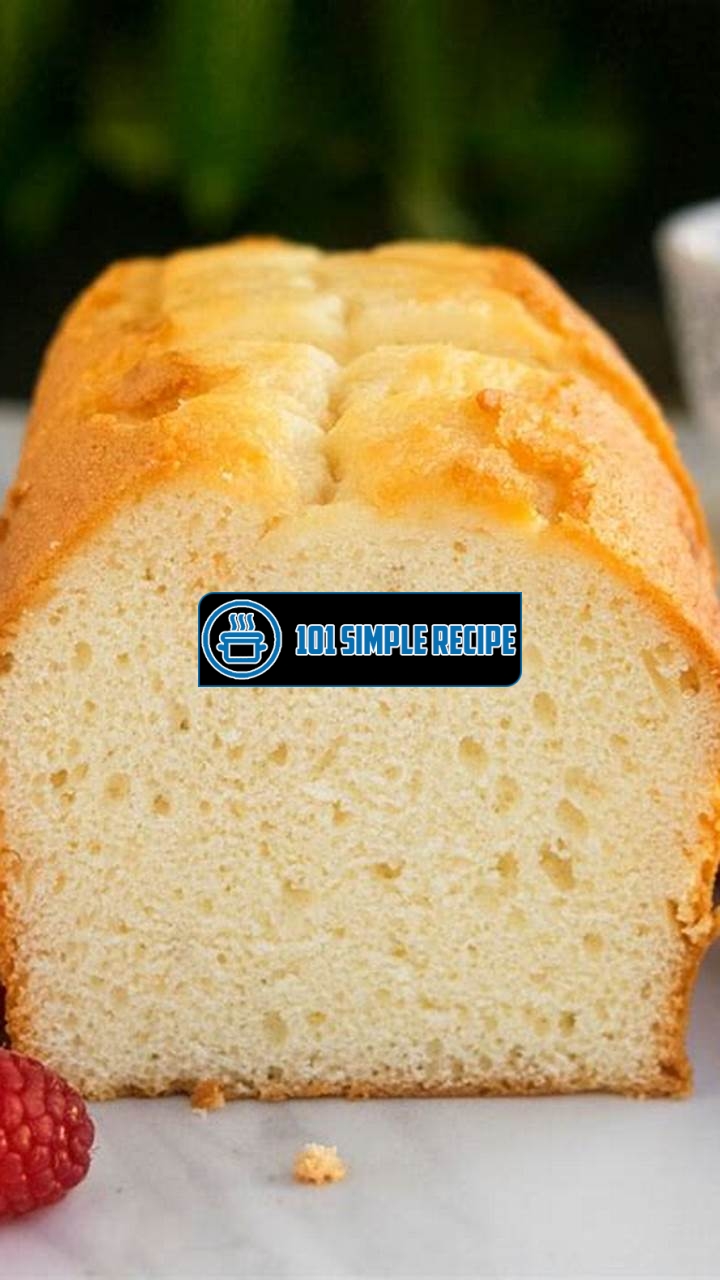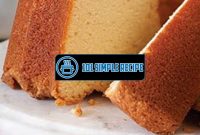Are you ready to turn your kitchen into a haven for homemade delights? If so, let’s start by mastering the art of baking a homemade pound cake. With its rich, buttery flavor and moist, dense texture, a pound cake is a classic treat that can bring comfort and joy to any occasion. Whether you’re a novice baker or a seasoned pro, this article will guide you through the step-by-step process of creating the perfect pound cake from scratch. So, tie up your apron and prepare to embark on a baking adventure that will leave you with a delectable dessert to share with family and friends.

Understanding Pound Cake
Pound cake is a classic dessert that has been enjoyed by generations. Its rich flavor, dense texture, and buttery taste make it a favorite among many. In this section, we will explore the history, characteristics, and popularity of pound cake as a beloved homemade treat.
Origins of Pound Cake
The origins of pound cake can be traced back to Europe in the 18th century. It is believed to have derived its name from the traditional recipe, which used a pound of each ingredient – flour, butter, eggs, and sugar. This simplicity in measurement made the recipe easy to remember and replicate.
The early versions of pound cake were quite different in texture compared to the ones we enjoy today. The original recipe did not include any leavening agents, such as baking powder or yeast, resulting in a denser and heavier cake. However, this dense texture was favored as it allowed the cake to last longer and withstand transportation during long journeys.
Unique Characteristics of Pound Cake
One of the unique characteristics of pound cake is its buttery and velvety texture. The high fat content from the butter gives it a moist and tender crumb that melts in your mouth. Additionally, the use of a large number of eggs contributes to its richness and adds a delightful eggy flavor to the cake.
Another remarkable feature of pound cake is its versatility. It serves as an excellent base for various flavors, allowing bakers to experiment with different ingredients. From adding citrus zest to incorporating chocolate chips, the possibilities are endless when creating flavorful variations of pound cake.
Pound Cake Variations
Over the years, pound cake has evolved, giving rise to numerous variations. While the traditional recipe remains popular, modern bakers have introduced exciting twists to this classic dessert. Here are a few notable pound cake variations:
- Lemon Pound Cake: Adding lemon zest and juice creates a tangy and refreshing flavor profile.
- Marble Pound Cake: Swirling chocolate or vanilla batter into the cake results in a visually appealing and delicious treat.
- Almond Pound Cake: Incorporating almond extract or chopped almonds adds a delightful nutty flavor to the cake.
- Coconut Pound Cake: Mixing shredded coconut into the batter creates a tropical twist and adds extra moisture.
These variations showcase the adaptability of pound cake, making it suitable for various occasions and preferences.
Note: Pound cake can be enjoyed on its own or served with whipped cream, fresh berries, or a dusting of powdered sugar for an extra touch of sweetness.
In conclusion, pound cake has a rich history, unique characteristics, and a wide range of delicious variations. Its enduring popularity is a testament to its timeless appeal as a homemade dessert. Whether you’re a novice baker or an experienced pastry chef, mastering the art of baking a homemade pound cake will undoubtedly impress and delight your family and friends.
Essential Ingredients
When it comes to baking a homemade pound cake from scratch, having the right ingredients is crucial. Without them, your cake may not turn out as delicious and moist as you’d like. In this section, we will explore the essential ingredients that you need to create the perfect pound cake.
Butter: The Foundation of Pound Cake
Butter is an essential ingredient in any pound cake recipe. It serves as the foundation of the cake, providing richness and flavor. Make sure to use unsalted butter, as it allows you to control the salt content in the cake. Using salted butter may result in a cake that is too salty.
It’s important to ensure that the butter is at room temperature before using it in the recipe. Softened butter blends more easily with the other ingredients, resulting in a smoother batter. Allow the butter to sit at room temperature for about 30 minutes before starting the baking process.
Tip: Softened butter should be cool to the touch, but easily spreadable.
Sugar: Sweetness and Moisture
In addition to its sweetness, sugar plays a vital role in adding moisture to the pound cake. Granulated sugar is commonly used in pound cake recipes, but you can experiment with other types of sugars, such as brown sugar or powdered sugar, to achieve different flavors and textures.
When incorporating sugar into the batter, it’s important to cream it together with the butter until light and fluffy. This step helps to incorporate air into the batter, resulting in a lighter and more tender cake.
Note: If using brown sugar, make sure to pack it firmly to measure accurately.
Flour: Structure and Texture
Flour provides the structure and texture of the pound cake. All-purpose flour is the most commonly used type of flour in pound cake recipes, as it balances the cake’s texture and density. However, you can also experiment with other types of flour, such as cake flour or whole wheat flour, to achieve different results.
When measuring flour, it’s crucial to use the proper technique to avoid adding too much or too little. Spoon the flour into the measuring cup and level it off with a knife. Avoid packing the flour, as it can result in a denser cake.
Pro Tip: For a lighter texture, you can sift the flour before measuring and adding it to the batter.
In conclusion, mastering the art of baking a homemade pound cake requires careful attention to the essential ingredients. The combination of butter, sugar, and flour creates a deliciously moist and flavorful cake. Remember to use unsalted butter, cream the sugar and butter together, and measure the flour accurately to achieve the best results. With practice and a few tweaks to the recipe, you’ll soon be baking pound cakes that rival those of professional bakers.
Mastering the Mixing Technique
When it comes to baking a homemade pound cake, mastering the mixing technique is key to achieving the perfect texture and crumb. By following the correct method, you can ensure that your pound cake turns out moist, tender, and delicious. In this section, we will guide you through the three vital steps: creaming butter and sugar, incorporating eggs, and adding dry ingredients.
Creaming Butter and Sugar
The first step in mixing the perfect pound cake batter is to cream together the butter and sugar. This process creates a light and fluffy base for the cake. To accomplish this, start by using room temperature butter. Softened butter will blend more easily with the sugar and result in a smoother batter. In a large mixing bowl, add the softened butter and granulated sugar. Mix them together until they are well combined and creamy, taking care not to overmix. Overmixing can cause the butter to become too incorporated with air, which may result in a dense and heavy cake.
Incorporating Eggs
The next step is to incorporate the eggs into the creamed butter and sugar mixture. One important tip here is to add the eggs one at a time, ensuring each egg is fully incorporated before adding the next one. This method helps to prevent the batter from curdling and ensures a smooth consistency. Additionally, make sure to use room temperature eggs as they blend more easily and evenly into the batter. Adding cold eggs may cause the batter to separate. Once all the eggs are added, continue mixing until the batter is smooth and creamy.
Addition of Dry Ingredients
Now that you have a creamy base, it’s time to add the dry ingredients. The dry ingredients typically include all-purpose flour, baking powder, and salt. Sift the dry ingredients together into a separate bowl to remove any lumps and ensure even distribution. Gradually add the dry ingredients to the butter and egg mixture, mixing on low speed until just combined. Avoid overmixing at this stage as it can lead to a tougher and less tender pound cake. The goal is to fully incorporate the dry ingredients without overworking the batter. Once the dry ingredients are mixed in, your pound cake batter is ready to be baked.
By mastering the mixing technique of creaming the butter and sugar, incorporating the eggs, and adding the dry ingredients, you can create a homemade pound cake with the perfect texture and crumb. Remember to mix each step carefully, ensuring that all the ingredients are fully incorporated before moving on to the next stage. Happy baking!
Want to shed some pounds while still enjoying a tasty treat? Our weight loss recipe is perfect for you. It’s low in calories and packed with nutritious ingredients.
Baking and Cooling
To master the art of baking a homemade pound cake, it is crucial to understand the optimal baking and cooling process. This ensures that you achieve a delicious and perfectly textured pound cake that will impress your friends and family. Paying attention to details such as choosing the right pan, setting the correct oven temperature, and properly cooling and unmolding the cake is essential to your success. Let’s delve into each of these aspects to ensure you have all the necessary knowledge to create a pound cake masterpiece.
Choosing the Right Pan
The choice of a pan significantly impacts the outcome of your pound cake. Opting for the right pan can make a world of difference when it comes to achieving a moist and evenly baked cake. A traditional option for a pound cake is a loaf pan due to its cylindrical shape and supreme heat distribution. This shape ensures that the cake bakes uniformly, resulting in a golden-brown crust and a tender crumb. Alternatively, you can also use a Bundt pan to add a stunning visual element to your pound cake.
When selecting a pan, it is important to consider the material it is made of. Non-stick pans offer the advantage of easy cake release, but they may produce a lighter crust. On the other hand, aluminum or stainless steel pans conduct heat more efficiently, resulting in a darker and crisper crust. Ultimately, the choice between non-stick and traditional pans depends on your personal preference.
Setting the Oven Temperature
The temperature at which you bake your pound cake plays a crucial role in its final outcome. Preheating the oven is a vital step to ensure even heat distribution throughout the baking process. Set your oven to 325°F (165°C) for a pound cake recipe from scratch.
Always place your pound cake in the center of the oven to allow for consistent heat flow. Avoid placing it too close to the top or bottom of the oven, as this can lead to uneven baking and result in a dry or undercooked cake. Additionally, it is recommended to use an oven thermometer to verify that the temperature is accurate, as oven dials are not always precise.
Proper Cooling and Unmolding
Once your pound cake is perfectly baked, it’s essential to let it cool properly before unmolding. This step ensures that the cake retains its shape and prevents it from sticking to the pan. Allow the cake to cool in the pan for about 10-15 minutes after removing it from the oven.
To safely remove the cake, gently run a knife along the edges to loosen it from the sides of the pan. Place a cooling rack on top of the pan, then swiftly invert the cake and pan together, allowing the cake to release onto the cooling rack. This method ensures a smooth transition and minimizes the risk of damaging your pound cake.
Finally, let the cake cool completely on the cooling rack before slicing and serving. This step is essential as it allows the flavors and textures to fully develop. Rushing the cooling process may result in a cake that is still moist but lacks the desired density and structure.
Mastering the art of baking a homemade pound cake requires attention to detail during the baking and cooling process. Choosing the right pan, setting the oven temperature correctly, and properly cooling and unmolding the cake all contribute to achieving the perfect pound cake. By following these guidelines, you’ll create a pound cake that is both visually appealing and incredibly delicious.
If you’re looking for a delicious pound cake recipe from scratch, look no further. Our White Castle recipe is a must-try. It’s moist, buttery, and packed with flavor.
Delicious Pound Cake Variations
When it comes to baking, there’s nothing quite as satisfying as mastering the art of making a homemade pound cake. The buttery richness and delicate texture of a pound cake are hard to resist. And while a classic pound cake is undeniably delicious on its own, why not take it up a notch with some creative variations? In this article, we will explore three mouthwatering pound cake variations that are sure to impress your friends and family.
Citrus Infused Pound Cake
If you’re a fan of bright and zesty flavors, then a citrus-infused pound cake is a must-try. This variation adds a refreshing twist to the traditional recipe, and the combination of tangy citrus fruits brings a burst of flavor to every bite. To make this delightful cake, you’ll need fresh lemon, orange, and lime zest, as well as their juices. The citrus zest adds a fragrant aroma, while the juices add a tangy taste that complements the buttery pound cake perfectly.
To make the citrus-infused pound cake, simply follow your favorite pound cake recipe from scratch and add the freshly grated zest of one lemon, one orange, and one lime to the batter. You should also replace a portion of the liquid in the recipe with the freshly squeezed juices. The result? A moist and citrusy pound cake that will transport your taste buds to sunny citrus groves.
Chocolate Swirl Pound Cake
Chocolate lovers, this one is for you! The chocolate swirl pound cake is a delightful combination of rich chocolate and buttery pound cake. The best part? It looks as good as it tastes! To achieve the irresistible chocolate swirl, you’ll need to prepare a simple chocolate batter alongside the classic pound cake batter.
Once you have both batters ready, spoon them alternatively into the prepared cake pan and use a butter knife to gently swirl them together. The result is a beautiful marbled pattern with a heavenly chocolate flavor. This variation is perfect for special occasions or when you’re craving something a little extra indulgent.
Marble Pound Cake
Another variation that offers a beautiful marbled effect is the classic marble pound cake. With its contrasting swirls of chocolate and vanilla, this cake is an absolute showstopper. The key to achieving those perfect swirls is to divide the batter in two and mix melted chocolate into one portion, while leaving the other portion plain.
To create the marbled effect, simply spoon dollops of each batter alternately into the prepared cake pan and use a skewer or knife to gently swirl them together. The result is a stunning cake with swirls of chocolate and vanilla that will wow everyone who lays eyes on it. It’s the perfect dessert to impress your guests at any gathering.
With these delicious pound cake variations, you can take your baking skills to the next level. Whether you prefer the tangy citrus-infused pound cake, the indulgent chocolate swirl pound cake, or the stunning marbled pound cake, each variation offers a unique and delightful twist on the classic recipe. So, grab your apron and baking tools, and get ready to master the art of creating homemade pound cakes that will leave everyone asking for seconds!
Looking for a refreshing beverage to complement your pound cake? Try our punch bowl recipe. It’s fruity, colorful, and the perfect addition to any gathering.
Thank you for taking the time to read our article on making a delicious pound cake from scratch. We hope you found the recipe and tips helpful.
If you have any further questions or suggestions, please feel free to leave a comment below. We value your feedback and would love to hear about your experience with this recipe.
Remember to bookmark our page and visit again later for more mouthwatering recipes and baking tips. Don’t miss out on our upcoming articles and updates!
Frequently Asked Questions
Here are some frequently asked questions about making pound cake from scratch.
| No. | Questions | Answers |
|---|---|---|
| 1 | Can I use a different type of flour for this recipe? | We recommend using all-purpose flour for the best results. Other types of flour may affect the texture and taste of the pound cake. |
| 2 | Can I substitute the butter with a margarine? | While it is possible to substitute butter with margarine, keep in mind that it may alter the flavor and texture of the pound cake. Butter is recommended for the authentic taste and texture. |
| 3 | How long can I store the pound cake? | The pound cake can be stored in an airtight container at room temperature for up to five days. For longer storage, you can refrigerate it for up to a week or freeze it for up to three months. |
| 4 | Can I add additional flavors or toppings? | Absolutely! Pound cake is versatile and you can experiment with different flavors and toppings. Some popular additions include lemon zest, vanilla extract, or a powdered sugar glaze. |
| 5 | Can I make this recipe gluten-free? | Yes, you can use a gluten-free all-purpose flour blend as a substitute for regular flour. However, be sure to check the label and follow the instructions for the best results. |
| 6 | Can I double the recipe to make a larger cake? | Yes, you can double the ingredients to make a larger pound cake. Just make sure to adjust the baking time accordingly and use a bigger baking pan. |
Closing Thoughts
We hope you enjoyed learning how to make a delectable pound cake from scratch. With simple ingredients and easy-to-follow instructions, you can create a moist and flavorful cake that will impress your friends and family.
Remember to share your own twists and variations on this classic recipe. Don’t be afraid to get creative and make it your own. Happy baking and we look forward to seeing you again soon!
Jump to Recipe
Pound Cake from Scratch

Learn how to make a delicious pound cake from scratch with this easy recipe. Moist and flavorful, this homemade pound cake will impress your friends and family.
- 2 cups all-purpose flour
- 1 ½ cups granulated sugar
- 1 cup unsalted butter (softened)
- 4 large eggs
- 1 cup milk
- 1 teaspoon vanilla extract
- 1 teaspoon baking powder
- ½ teaspoon salt
- Preheat your oven to 350°F (175°C). Grease and flour a 9-inch loaf pan.
- In a mixing bowl, whisk together the flour, baking powder, and salt. Set aside.
- In a separate mixing bowl, cream together the softened butter and granulated sugar until light and fluffy.
- Beat in the eggs, one at a time, and then mix in the vanilla extract.
- Gradually add the dry ingredients to the butter mixture, alternating with the milk. Begin and end with the dry ingredients, mixing until just combined.
- Pour the batter into the prepared loaf pan and smooth the top. Bake for approximately 60 minutes, or until a toothpick inserted into the center comes out clean.
- Allow the pound cake to cool in the pan for 10 minutes, then transfer it to a wire rack to cool completely. Slice and serve.






